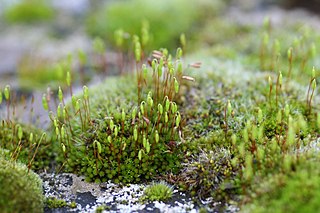
Spanish moss is an epiphytic flowering plant that often grows upon large trees in tropical and subtropical climates. It is native to much of Mexico, Bermuda, the Bahamas, Central America, South America, the Southern United States, and West Indies. It has been naturalized in Queensland (Australia). It is known as "grandpa's beard" in French Polynesia.

Physcomitrium is a genus of mosses, commonly called urn moss, that includes about 80 species and has a cosmopolitan distribution. The scientific name comes from the Ancient Greek words physa, meaning bladder, and mitrion, meaning little turban, which together refer to the urn-like calyptra. The common name is derived from its symmetrical, erect and urn-like capsules that lack peristomes, these features characterising the genus. They are commonly found on exposed soils that are often associated with locations that become very wet in the spring, such as along river banks or on alluvial mud. They occur from near sea level to about 2500 metres. The capsules mature over the winter and into the spring.

Allium textile is a common species of wild onion found in the central part of North America.
Andreaeobryum, the Mossy Cowl Moss, is a genus of moss with a single species Andreaeobryum macrosporum, endemic to Alaska and western Canada. The genus is placed as a separate family, order and class among the mosses.

Tetraphidaceae is a family of mosses. It includes only the two genera Tetraphis and Tetrodontium, each with two species. The defining feature of the family is the 4-toothed peristome.

Bryales is an order of mosses.

Timmia is a genus of moss. It is the only genus in the family Timmiaceae and order Timmiales. The genus is named in honor of the 18th-century German botanist Joachim Christian Timm.

Polytrichum is a genus of mosses — commonly called haircap moss or hair moss — which contains approximately 70 species that cover a cosmopolitan distribution. The genus Polytrichum has a number of closely related sporophytic characters. The scientific name is derived from the Ancient Greek words polys, meaning "many", and thrix, meaning "hair". This name was used in ancient times to refer to plants with fine, hairlike parts, including mosses, but this application specifically refers to the hairy calyptras found on young sporophytes. A similar naming related to hair appears in Old Norse, haddr silfjar, "hair of Sif", goddess from Norse Mythology, wife of the god Thor. There are two major sections of Polytrichum species. The first — section Polytrichum — has narrow, toothed, and relatively erect leaf margins. The other — section Juniperifolia — has broad, entire, and sharply inflexed leaf margins that enclose the lamellae on the upper leaf surface. Polytrichum reproduce by vegetative and sexual methods.

Physcomitrium pyriforme, commonly known as common bladder-moss, is a bryophyte native to all continents except South America and Antarctica. Its capsules mature beginning in late fall and through the spring. It is most commonly found in wet soils in disturbed locations. A highly variable species, size, leaf characters and shape of the capsule vary across its range, but often within populations as well.

Spinulum annotinum, synonym Lycopodium annotinum, known as interrupted club-moss, or stiff clubmoss, is a species of clubmoss native to forests of the colder parts of North America, as well as Asia, and most of Europe. The genus Spinulum is accepted in the Pteridophyte Phylogeny Group classification of 2016, but not in other classifications, which submerge the genus in Lycopodium.

Lycopodiella inundata is a species of club moss known by the common names inundated club moss, marsh clubmoss and northern bog club moss. It has a circumpolar and circumboreal distribution, occurring throughout the northern Northern Hemisphere from the Arctic to montane temperate regions in Eurasia and North America. It grows in wet habitat, such as bogs, ponds, moist spots on the tundra, and long-standing borrow pits.

Rhizomnium punctatum, also called dotted thyme-moss, is a small species in the genus Rhizomnium.
Rhizomnium dentatum is an extinct species of moss in the family Mniaceae. The species is solely known from the Middle Eocene Baltic amber deposits in the Baltic Sea region of Europe. The genus contains a total of thirteen extant species distributed across the northern hemisphere.

Mniaceae is a moss family in the order Bryales.

Plagiomnium is a genus of mosses in the family Mniaceae. It was formerly a part of a more encompassing genus Mnium and in 1968 Finish bryologist Timo Juhani Koponen justified splitting the genus into a number of smaller genera.

Warnstorfia fluitans, the floating hook-moss or water hook-moss, is a species of moss found in acidic habitats across all continents except Antarctica.

Rhizomnium appalachianum is a species of moss in the family Mniaceae native to the Eastern United States and Canada, from Manitoba to Newfoundland and south to South Carolina. It grows 4-8cm tall, and has relatively large leaves for a moss which are typically 6.5mm wide and 10mm long. The stems are covered in reddish hairs. It grows in wet areas such as along streams and in seeps and especially the edges where there is a transition from wet to dry.
Albert LeRoy Andrews (1878–1961) was a professor of Germanic philology and an avocational bryologist, known as "one of the world’s foremost bryologists and the American authority on Sphagnaceae." From 1922 to 1923 he was the president of the Sullivant Moss Society, renamed in 1970 the American Bryological and Lichenological Society.

Rhizomnium pseudopunctatum is a species of moss belonging to the family Mniaceae.

Mnium is a genus of mosses belonging to the family Mniaceae. The species of this genus are found in Europe and North America.















